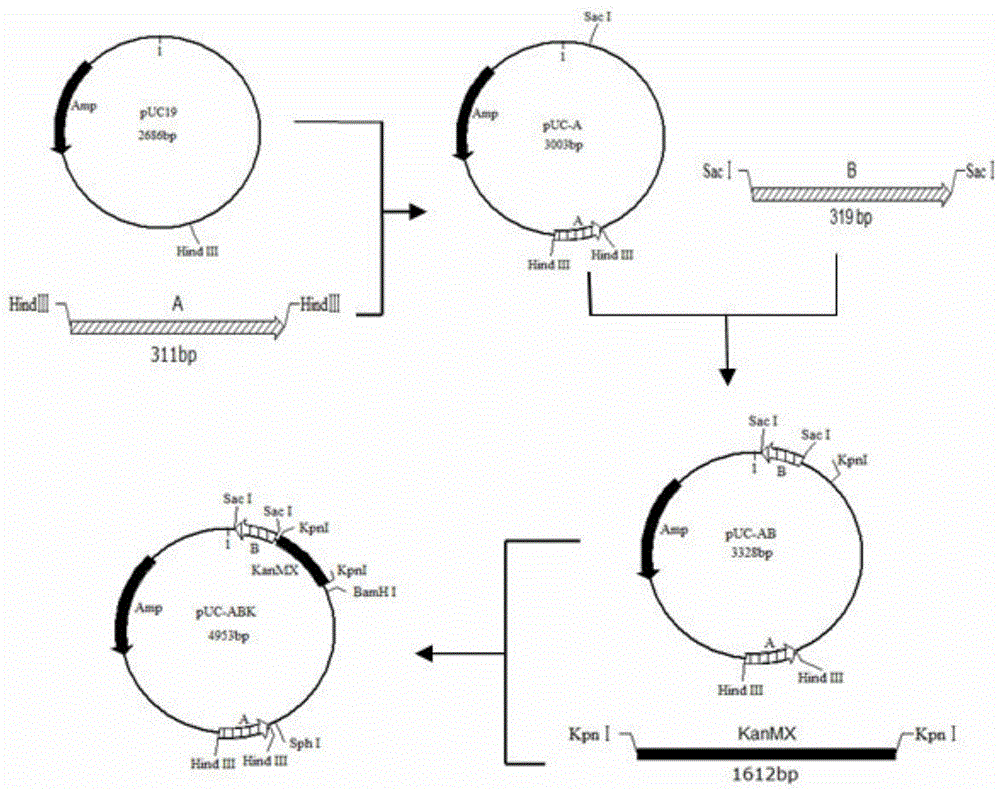A strain of Saccharomyces cerevisiae capable of reducing biogenic amines in rice wine and its construction method and application
A technology of Saccharomyces cerevisiae and biogenic amine, which is applied in the field of molecular biology and achieves the effect of wide application prospects
- Summary
- Abstract
- Description
- Claims
- Application Information
AI Technical Summary
Problems solved by technology
Method used
Image
Examples
Embodiment 1
[0068] According to the yeast genome data in Genebank and the integrated plasmid sequence, the primers in the following examples were designed.
[0069] Table 1. Primers used in this example
[0070]
[0071] The construction process of genetically engineered bacteria of the present invention is as follows:
[0072] 1) The upstream homology arm A segment of the homologous recombination of the purified PEP4 propeptide gene was single-digested with Hind III, and connected with the pUC19 plasmid after the same digestion to construct recombinant plasmid 1;
[0073] 2) performing a single enzyme digestion on the downstream homology arm B fragment of the purified PEP4 propeptide gene homologously recombined with Sac I, and connecting it with the recombinant plasmid 1 after the same digestion to construct recombinant plasmid 2;
[0074] 3), the KanMX gene fragment is single-digested with Kpn I, and connected with the recombinant plasmid 2 after the same digestion, to construct th...
Embodiment 2
[0081] Take one ring each of the genetically engineered bacteria obtained in Example 1 and the starting strain Saccharomyces cerevisiae RY1, inoculate them in 5 mL of wort medium, 30 ° C, 150 r / min, shake the flask for 12 hours and then transfer them to the same wort culture medium. In a 50mL Erlenmeyer flask, 30°C, 150r / min, continue to shake the flask for 24 hours, then inoculate 10% of the inoculum into the rice solid medium, and carry out the pre-fermentation experiment in a 30°C constant temperature incubator. After 5 days, adjust the constant temperature incubator After the temperature reached 30°C, the fermentation experiment was carried out for 15 days. After the fermentation, the supernatant was taken to pass through the membrane, and the liquid chromatography was ready for testing. At the same time, the fermentation broth was analyzed, including weight loss, residual sugar, alcohol content, and the content of important aroma substances. The results are shown in Table...
PUM
 Login to View More
Login to View More Abstract
Description
Claims
Application Information
 Login to View More
Login to View More - R&D
- Intellectual Property
- Life Sciences
- Materials
- Tech Scout
- Unparalleled Data Quality
- Higher Quality Content
- 60% Fewer Hallucinations
Browse by: Latest US Patents, China's latest patents, Technical Efficacy Thesaurus, Application Domain, Technology Topic, Popular Technical Reports.
© 2025 PatSnap. All rights reserved.Legal|Privacy policy|Modern Slavery Act Transparency Statement|Sitemap|About US| Contact US: help@patsnap.com



